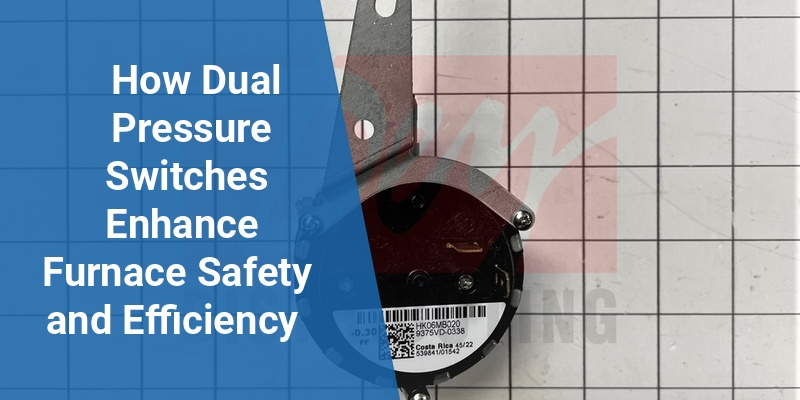Furnace systems rely on several critical components to ensure safe and efficient operation. Among these, the dual pressure switch plays a pivotal role in monitoring and managing air pressure within the furnace’s venting and combustion systems. This article explores the function, significance, troubleshooting, and maintenance of dual pressure switches in residential and commercial furnaces, offering a comprehensive guide for homeowners, HVAC technicians, and facility managers.
| Aspect | Description |
|---|---|
| Function | Monitors positive and negative air pressure to confirm proper airflow |
| Importance | Prevents unsafe furnace operation by ensuring venting and combustion safety |
| Common Issues | Clogged tubing, faulty diaphragm, electrical failures causing furnace lockout |
| Maintenance Tips | Regular inspection, cleaning of pressure tubing, testing switch continuity |
What Is a Dual Pressure Switch in a Furnace?
A dual pressure switch is an electrical safety device used in furnaces to monitor two different pressure points—typically positive and negative pressures—in the air intake and exhaust venting systems. This switch verifies that the inducer motor and venting pathways are working correctly, making sure the furnace can safely ignite and operate.
Unlike a single pressure switch, the dual pressure system provides enhanced safety by confirming more than one air pressure condition before the furnace proceeds to the ignition phase. This dual verification helps protect against issues such as blocked vents, malfunctioning inducer motors, or unsafe combustion conditions.
How Dual Pressure Switches Work in Furnace Systems
The induction blower motor in a furnace creates airflow that must be correctly routed through the heat exchanger and vent pipes to expel combustion gases safely. The dual pressure switch monitors:
- Negative Pressure Side: It detects vacuum created by the inducer motor inside the vent pipe to ensure proper draft.
- Positive Pressure Side: It senses the buildup of pressure in the combustion chamber or other specified areas.
Only when both pressure conditions meet preset thresholds will the furnace’s control board allow ignition to proceed, ensuring the system operates under safe airflow conditions.
Why Dual Pressure Switches Are Critical for Furnace Safety
Ensuring safe combustion and venting is mandatory to prevent carbon monoxide buildup, fire hazards, and equipment damage. The dual pressure switch acts as a safeguard by:
- Shutting down the furnace if airflow is obstructed.
- Preventing ignition if exhaust gases can’t be vented properly.
- Protecting the heat exchanger from cracking due to improper ventilation.
This level of control significantly reduces risks associated with furnace malfunctions and helps comply with HVAC safety codes.
Call 888-906-9139 for Free Local HVAC Quotes – No Obligation, Just Savings!
Common Problems with Dual Pressure Switches and How to Troubleshoot
Furnace malfunctions related to dual pressure switches often present symptoms like furnace lockout, error codes on the control board, or failure to ignite. Typical issues include:
| Problem | Cause | Troubleshooting Step |
|---|---|---|
| Pressure Switch Not Closing | Blocked tubing or vent pipe | Check and clear any obstructions in the tubing and venting |
| Switch Fails to Open or Close Electrically | Faulty diaphragm or electrical contacts | Test switch continuity with a multimeter; replace if defective |
| Inducer Motor Malfunction | Motor failure or wiring issues | Inspect inducer motor operation and wiring connections |
| Loose or Damaged Tubing | Air leaks affecting pressure readings | Replace cracked or disconnected tubing |
Maintaining Dual Pressure Switches for Long-Term Furnace Performance
Routine maintenance of dual pressure switches helps avoid sudden furnace failures. Recommended practices include:
- Inspect pressure tubing for cracks or blockages during annual service.
- Use diagnostic tools to verify pressure readings and switch continuity.
- Keep the inducer motor and vent system free of debris and corrosion.
- Replace pressure switches per manufacturer guidelines, usually every few years.
Regular maintenance ensures the switch functions reliably, improving overall furnace efficiency and extending the lifespan of the heating system.
Choosing and Replacing Dual Pressure Switches
When replacing a dual pressure switch, it is crucial to select a compatible model matching the furnace’s specifications. Factors include:
- Pressure settings and switch ratings.
- Electrical connector type and wiring compatibility.
- Manufacturer recommendations and certification.
Improper replacement can cause system malfunctions, so professional HVAC service is strongly recommended for installations and testing.
Impact of Dual Pressure Switches on Furnace Efficiency
By confirming proper airflow and combustion conditions, dual pressure switches contribute indirectly to the furnace’s energy efficiency. A well-maintained pressure system:
- Prevents the furnace from cycling inefficiently.
- Ensures complete and safe combustion of fuel.
- Reduces the risk of costly repairs from damage caused by venting failures.
Ultimately, this promotes lower energy bills and a safer indoor environment.
Call 888-906-9139 for Free Local HVAC Quotes – No Obligation, Just Savings!
